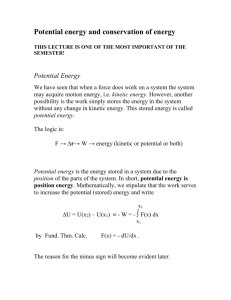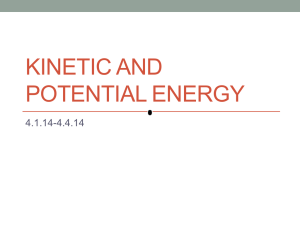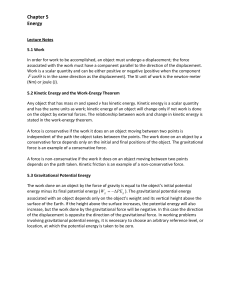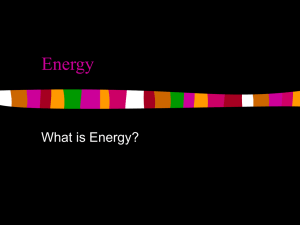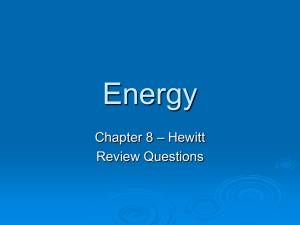FE5
advertisement
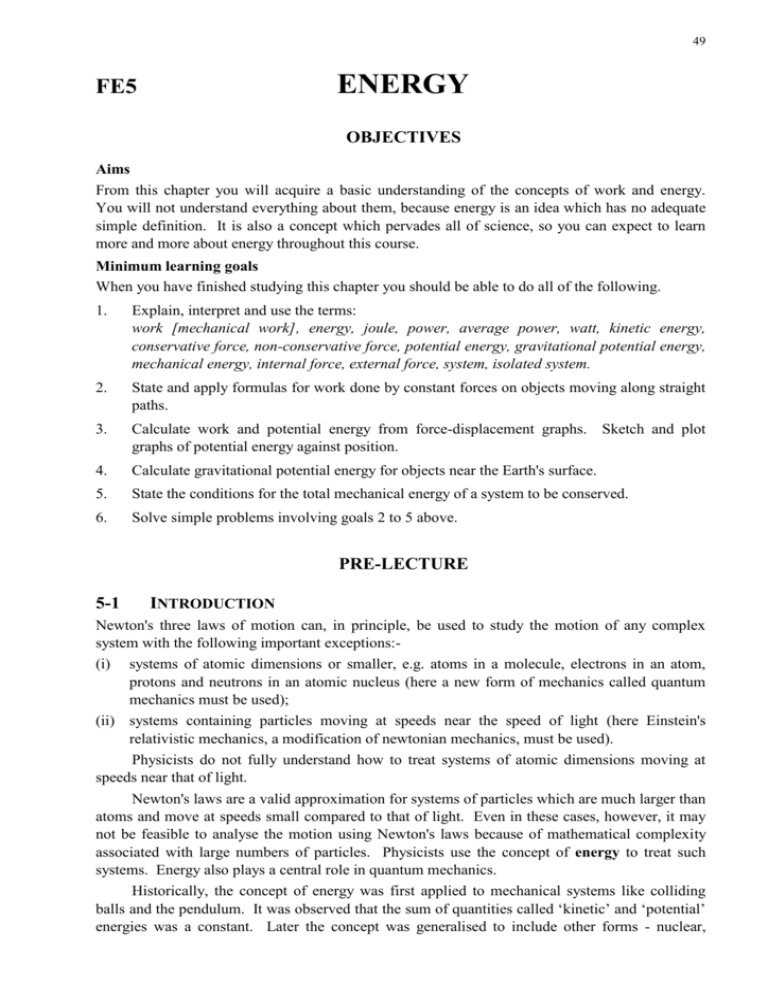
49 ENERGY FE5 OBJECTIVES Aims From this chapter you will acquire a basic understanding of the concepts of work and energy. You will not understand everything about them, because energy is an idea which has no adequate simple definition. It is also a concept which pervades all of science, so you can expect to learn more and more about energy throughout this course. Minimum learning goals When you have finished studying this chapter you should be able to do all of the following. 1. Explain, interpret and use the terms: work [mechanical work], energy, joule, power, average power, watt, kinetic energy, conservative force, non-conservative force, potential energy, gravitational potential energy, mechanical energy, internal force, external force, system, isolated system. 2. State and apply formulas for work done by constant forces on objects moving along straight paths. 3. Calculate work and potential energy from force-displacement graphs. Sketch and plot graphs of potential energy against position. 4. Calculate gravitational potential energy for objects near the Earth's surface. 5. State the conditions for the total mechanical energy of a system to be conserved. 6. Solve simple problems involving goals 2 to 5 above. PRE-LECTURE 5-1 INTRODUCTION Newton's three laws of motion can, in principle, be used to study the motion of any complex system with the following important exceptions:(i) systems of atomic dimensions or smaller, e.g. atoms in a molecule, electrons in an atom, protons and neutrons in an atomic nucleus (here a new form of mechanics called quantum mechanics must be used); (ii) systems containing particles moving at speeds near the speed of light (here Einstein's relativistic mechanics, a modification of newtonian mechanics, must be used). Physicists do not fully understand how to treat systems of atomic dimensions moving at speeds near that of light. Newton's laws are a valid approximation for systems of particles which are much larger than atoms and move at speeds small compared to that of light. Even in these cases, however, it may not be feasible to analyse the motion using Newton's laws because of mathematical complexity associated with large numbers of particles. Physicists use the concept of energy to treat such systems. Energy also plays a central role in quantum mechanics. Historically, the concept of energy was first applied to mechanical systems like colliding balls and the pendulum. It was observed that the sum of quantities called ‘kinetic’ and ‘potential’ energies was a constant. Later the concept was generalised to include other forms - nuclear, FE5: Energy chemical, radiation (light), electrical, heat and sound energy. The divisions between these forms are somewhat arbitrary. For example, thermal energy is now understood to be nothing more than mechanical energy of the atoms and molecules of the system. Energy is conserved but may be transformed from one form to another, e.g. mechanical energy to heat, etc. This chapter is one of the key parts of this course. It describes the two forms of mechanical energy (kinetic and potential) and how energy is transferred to systems by means of a process called mechanical work. Under certain circumstances, the total mechanical energy (the sum of the kinetic and potential energies) of a system remains constant in time. This result can be used to study the motions of particles in very small systems such as nuclei, atoms and molecules, as well as in large scale systems. The SI unit of energy and work is the joule (J); l J = 1 N.m = l kg.m2.s-2. To give some idea of the size of a joule: it is the energy required to raise an object weighing 1 newton (a mass of about 0.1 kg on Earth) e.g. an apple, by 1 metre. Power means rate of transfer of energy. In purely mechanical systems this is equal to the rate at which work is done by some force. The SI unit of power is the watt (W); l W = l J.s-l. For example a 100 W light globe transfers 100 J of electrical energy to heat and radiation in 1 s. And lifting an apple weighing 1 N a height of 1 m in 1 s corresponds to an average power of 1 W. The buoyant force exerted on objects by the air will be neglected throughout this chapter since it is very small compared to the weight of the objects considered. (See, for example, question 3.10 in chapter FE3.) LECTURE 5-2 ENERGY TRANSFERS IN THE SOLAR ENERGY CYCLE With the exception of some nuclear fuels, geothermal and tidal power, the sun is the ultimate source of energy within the solar system. Hydrogen nuclei within the sun combine to release energy as heat which is transferred to radiation near the surface of the sun. Some of this radiation is converted to chemical and thermal energy at the Earth. Radiation is absorbed directly by molecules in the atmosphere and at the Earth's surface and appears as thermal energy. This energy is partially re-emitted as radiation; the remainder is transferred to mechanical energy, for example in atmospheric motions and in the water cycle. The leaves of plants use radiant energy to convert carbon dioxide and water to carbohydrates by photosynthesis. This energy undergoes further chemical conversion in animal life and can also be recovered by burning fossil fuels such as coal and oil. (If you are interested, see the diagram in the interlude following this chapter and Scientific American, September 1970, for further details.) 5-3 MECHANICAL WORK - A MEANS OF ENERGY TRANSFER Work is a measure of energy transfer. Work is done by a force acting on an object whenever the object moves. If there are several forces acting on the same object then each of them does work. (This is different from the colloquial use of the word ‘work’ - in the physics definition, no work is done if there is no movement.) 50 51 FE5: Energy Work done by a constant force for straight-line motion Case (i): Force parallel to the motion Consider first the simple case of a particle moving along a straight path, being acted on by a constant force F, which acts in the same direction as the motion. W = F (x l - x 0) , i.e. the work is equal to the product of the force and the displacement. Case (ii): Force at an angle to the motion In this case we consider a constant force in a direction which makes a constant angle to the direction of the motion. Work is done only by the component, Fx , of the force which is parallel to the line of motion. The work done by the constant force as the particle goes from position x0 to a point x l is: W = Fx∆x = F cos(x1 - x0) ... ( 5.1) . • • • Note the following. Case (i) is a special instance of (ii) with = 0. The component of F perpendicular to the line of motion does no work. The work done by F is the same as that done by Fx alone. • The work done is positive if the component Fx is in the direction of motion and negative if Fx is opposed to the direction of motion; i.e. if the force is ‘holding back’ the object, it does negative work. • If the constant force component Fx is plotted as a function of the position x of the object, the work done is represented by the area between the graph and the x axis from x0 to xl as shown in figure 5.1. Parallel force component Fx W x0 Figure 5.1 x 1 Position x Work done by a constant force during a straight-line displacement Sign convention for graphs In drawing graphs we arbitrarily choose a particular direction and call it positive. If Fx and the displacement (∆x = xl - x0) are both positive or both negative, then W is positive. However if Fx and the displacement have opposite signs (i.e. if the force is opposed to the direction of motion) then W is negative. 52 FE5: Energy Motion in a straight line with a variable force Now consider the case where F is an arbitrary force, so that Fx varies with position x as the body moves along a straight path. On a graph of Fx against x the work W is now represented by the area between the curve and the x axis (with the above sign convention) See figure 5.2. Parallel force component Fx ( x ) x + 0 x - Figure 5.2 1 Position x Work done by a variable force in straight line motion Only the component F of the force which is parallel to the straight path does any work. x The procedure illustrated in figure 5.2 is equivalent to the evaluating the integral W x1 x 2 Fx dx . ... (5.2) General case In the most general case of all, in which the motion is along a curved path, work can be defined by considering a variable coordinate direction which is everywhere parallel (tangential) to the path traced out by the moving object. The coordinate x is replaced by a coordinate measured along the path, whose magnitude is equal to distance, s, along the curved path. Consider a graph of the tangential component, Fˆ, of the force plotted against the coordinate s. Then the work done by the force F is represented by the area under the curve, exactly as in the one-dimensional case. 5-4 TRANSFER OF ENERGY TO SYSTEMS BY MECHANICAL WORK A force doing a positive amount of work on a system transfers energy to that system. The energy can end up in one or more of the following forms:• non-mechanical energy, • kinetic energy or • potential energy Non-mechanical energy An example is a system consisting of a rigid object and a rough surface over which the object moves (figure 5.3). The applied force does work on the object while the object moves at constant velocity, and energy is transferred to thermal energy at the surfaces in contact. Note that there must be an equal and opposite force - friction - acting on the object which balances the applied force, since we are told that the object is moving at constant velocity. 53 FE5: Energy Applied force Friction Figure 5.3 Object dragged across a rough surface Kinetic energy An example is a system consisting of an object and smooth (frictionless) surface on which it sits (figure 5.4). When a horizontal force is applied to the object there is no opposing force - the applied force increases the speed of the object and hence, also, its kinetic energy. Applied force Smooth surface Figure 5.4 Object dragged across a perfectly smooth surface The kinetic energy of an object of mass m travelling at speed v is defined to be K = 1 2 mv2 . ...(5.3) Potential energy An example is a system consisting of a rigid object, a smooth surface on which it sits and a spring connected as shown in figure 5.5. Suppose the applied force is pulling the object to the right at constant velocity, thereby stretching the spring. (Note that the applied force must be equal and opposite to the force exerted by the spring on the object since the velocity of the object is constant.) What happens to the energy transferred to the system as work is done by the applied force? Energy is not being transferred to either non-mechanical energy or kinetic energy, during this constant velocity motion. Figure 5.5 Spring opposing the motion Consider a situation where the spring is stretched with the object on the right. Suppose now that the applied force is reduced and kept slightly less than the force exerted by the spring. The object will move to the left towards the position where the spring is unstretched. During this process the force in the spring is doing work on the pusher (the object exerting the applied force), which is not part of the system. If the spring is ideal, the magnitude of the work done by the spring equals the work done by the applied force in extending the spring. The energy released by the system comes from the potential energy (PE) stored when the spring is stretched. Potential energy should be thought of as a property of the whole system and not of individual parts of the system. 54 FE5: Energy The force exerted by the spring is called conservative since the energy transferred to the system can be recovered directly as mechanical energy. There is always a conservative force associated with potential energy. Frictional forces and drag forces are called non-conservative since mechanical energy cannot be recovered directly by removing the applied force which produced the motion. 5-5 CONSERVATION OF MECHANICAL ENERGY Terminology An internal force is one exerted by one part of a system on another part of the system. An external force is one exerted by something outside the system on some part of the system. An isolated system is one on which no external forces are doing work, i.e one to which no mechanical energy is being added. The total mechanical energy of a system is the sum of its kinetic energy and its potential energy. Principle If there are no non-conservative forces acting within an isolated system, the total mechanical energy of the system is conserved (i.e. it remains constant as time progresses). It does not matter what we take as the zero of the potential energy because in any problem we are interested only in changes in energy : change in change in change in total mechanical energy = kinetic energy + potential energy . 5-6 CALCULATING POTENTIAL ENERGY How can the potential energy be found from the associated internal conservative force? Example In the spring example above - case (iii) - we usually choose PE = 0 when the spring has its natural length, neither extended nor compressed. Then the potential energy at extension x is equal to the work done by the force exerted by the spring in returning the object from x to 0. PE(x) Force exerted by spring at position x O x O x 55 FE5: Energy (a) Figure 5.6 (b) Force and potential energy for an ideal spring There is no component of F perpendicular to the motion, so in this instance Fx is the full force acting. The PE at x indicated in figure 5.6b is therefore represented by the shaded area in figure 5.6a. General procedure The general procedure for finding the potential energies of the various states of a system is as follows. (i) Assign zero PE to one state of the system. (ii) The PE of any other state of the system equals the work done by the internal conservative forces when the system moves from that state to the zero PE state. 5-7 WHY IS POTENTIAL ENERGY A USEFUL CONCEPT? In general the state of a system at any instant is specified by giving the positions and the velocities of all of the parts of the system. The PE of a state does not, however, depend on the velocities of the particles or on how the system came to be in that state. It depends only on the positions of the particles in the system (i.e. on their configuration). Therefore, the change in PE when the system moves from one state to another will depend only on the configurations of the particles in the two states and not on how the system moves between the states. Since the gravitational force is conservative and the electrostatic and the two nuclear forces are all conservative on atomic and nuclear scales, complicated processes can be studied comparatively easily using PE diagrams and the principle of conservation of mechanical energy. POST-LECTURE 5-8 ENERGY TRANSFERRED AS WORK - QUESTIONS The following two questions are designed to help you revise the definitions given in the lecture. An object of mass m slides down an incline at angle to the horizontal as shown. Q5.1 Figure 5.7 Object sliding down an incline What are the forces on the object? i) On figure 5.7 draw in all the forces acting on the object. ii) Which of these forces are doing work on the object ? iii) Which of the forces doing work on the object are conservative ? Which are non-conservative ? For the rest of this question assume that the non-conservative forces present are negligible. iv) What work is done by the gravitational force on the object when the latter slides a distance d down the incline ? What is the increase in kinetic energy of the object during this process? v) 56 FE5: Energy F Figure 5.8 Object dragged up an incline Draw in the forces. Suppose that a force F with magnitude F greater than mg sin is used to pull the object a distance d up the incline as shown in figure 5.8. What work is done by F ? What work is done by the gravitational force? What is the increase in the kinetic energy of the object during this process? Q5.2 An object of mass m swings at the end of a taut, straight unstretchable rope whose other end is fixed. Figure 5.9 A swinging object Draw in the forces. Which forces do work? i) On figure 5.9 draw in all the forces acting on the object. ii) Which of these forces are doing work on the object? iii) Which of the forces doing work on the object are conservative? Which are non-conservative? Assume that the non-conservative forces present are negligible. Suppose that the object is released from rest from some raised position with the rope taut. The work done on the object by the gravitational force when the object moves from the point of release to the lowest point of its swing equals the kinetic energy of the object at the lowest point. The object continues its swing until it momentarily comes to rest at some highest point on the other side. At this highest point the kinetic energy of the object is zero. Therefore the work done by the gravitational force when the object moves from the point of release to this highest point is zero. (Here the object moves along a curved path so it is difficult to calculate the work done by the gravitational force. This problem will be considered from a different viewpoint in Q5.4 below.) 5-9 GRAVITATIONAL PE NEAR THE EARTH'S SURFACE Consider a system consisting of an object of mass m and the Earth. For our purposes the Earth may be considered immovable so that all forces acting on it do no work. In any small region near the Earth's surface it is possible to choose any horizontal level and say that the system has zero PE when the object is on that level. If the object is at height h above this horizontal level the gravitational potential energy of this system is equal to mgh. If the object is a vertical distance h below this horizontal level, the PE is equal to -mgh . (A proof of this result will be outlined in Q5.10.) |U| = |mgh| ... (5.4) 57 FE5: Energy PE = mgh h PE = 0 h PE = -mgh Figure 5.10 Gravitational potential energy Note that these simple expressions hold only if h is small compared to the distance from the centre of the Earth. If this condition is not satisfied, the change in the gravitational force with height must be taken into account. 5-10 QUESTIONS Conservation of mechanical energy Q5.3 Consider the object sliding down the incline described in Q5.1. Assume that the non-conservative forces acting on the object are negligible. The system consisting of the object and the Earth is isolated according to the definition given in the lecture. (The incline can be treated as part of the Earth.) The gravitational force on the object is now internal to the system. i) Can you explain why this system is isolated? ii) Use the idea of conservation of mechanical energy and the above expressions for the gravitational potential energy to find the increase in kinetic energy of the object when it slides a distance d down the incline. (Do you get the same answer as that obtained using the method of Q5.1?) Q5.4 Consider the swinging object described in Q5.2. Assume that the non-conservative forces acting on the object are negligible. The system consisting of the object and the Earth (the string is not part of the system) is isolated. The gravitational force is now internal to the system. i) Can you explain why this system is isolated ? ii) Suppose that the object is released from rest from height h above the lowest point of its swing. Find the maximum kinetic energy of the object and the maximum height to which it rises on the other side. iii) How would your answers to part (ii) differ if non-conservative forces were not negligible? (Note that the system would then no longer be isolated.) Energy dissipation Q5.5 Use energy considerations to explain why an object thrown vertically into the air takes longer to fall than it does to rise if air resistance is taken into account (c.f. Q4.4 in FE4). Hint: consider the speed of the object at a given height on the upward and downward portions of its motion. Energy balances Q5.6 Flow of sap in trees A typical tall tree manages to raise water through a height of 20 m from roots to leaves at a rate of 700 kg per day. (Approximately 90% of this water is evaporated from the leaves, the remainder is used in the photosynthesis process.) What energy must be supplied in a day to raise this water? It is impossible to raise water to a height of more than about 10.3 metres using a vacuum pump which utilises atmospheric pressure. How do trees manage to accomplish this? (See Scientific American, March 1963, pp 132-142.) Q5.7 58 FE5: Energy v Figure 5.11 At what rate does the possum work? The metabolism of a possum of mass m is such that the possum is capable of doing work at a maximum rate of P. When the possum climbs a tall vertical tree at constant speed, it must do work at a rate equal to the rate of increase of the potential energy of the possum-Earth system. (We can neglect any nonconservative forces for the purposes of this discussion.) i) If the possum is moving at speed v, at what rate is it doing work? ii) If m = 3.0 kg and P = 60 W what is the shortest possible time in which the possum can climb a tree 20 m high ? (These ideas will be used in chapter FE8 on Scale) Machines Machines usually are devices for doing work using a small force travelling a large distance. For example on an inclined plane like a winding road, only a force large enough to overcome the component of gravity parallel to the plane (and any non-conservative forces present) is required. However, one must travel a longer distance to reach any given height. Q5.8 When using a lever like a crowbar, one applies a force at one end to raise a load at the other (figure 5.12). a b Applied force Load Figure 5.12 Lifting with a lever Compare forces and works. i) By considering torques about the pivot, find the ratio of the load, mg, to the minimum applied force F required to raise the load, in terms of the ratio of the lengths a and b of the lever on either side of the pivot point. You may neglect the weight of the lever. ii) If the load is raised a small height h, the work done by the minimum applied force must equal the increase, mgh, in the PE of the load-Earth system. How far does the applied force have to move its end of the lever? (Ignore the fact that the ends of the lever move in slightly curved paths.) Q5.9 Draw a schematic diagram of the main bones in the arm and the biceps muscle used to raise the forearm. Discuss qualitatively how this ‘machine’ in the human body differs from the machine used in Q5.8. Hint: consider the work done by the biceps muscle in raising a load held in the hand. Gravitational force and potential energy In questions 5.3 to 5.9 you used the result that the gravitational potential energy of an object-Earth system depends only on the height of the object. Question 5.10 outlines a proof of this result. Q5.10 59 FE5: Energy B A E D C F Figure 5.13 Work done by gravity Show that the work done by gravity does not depend on the path taken. In figure 5.13 A is on the same horizontal level as B which is vertically above C , a distance h below. i) Find the work done by the gravitational force on an object of mass m when the object moves from A to B as shown. ii) Find the work done when the object moves from B to C and hence the total work done when the object moves from A to C along the path A B C. iii) The path A D E F C is made up of straight vertical and horizontal segments as shown. Verify that the total work done by the gravitational force on the object when it moves from A to C along this path is equal to the result of (ii). A C Figure 5.14 Straight-line approximation to a curved path Any curved path from A to C can be approximated as closely as desired by a series of vertical and horizontal segments - see figure 5.14. The work done along the curved path is then approximately equal to the total work done along the straight line segments, i.e. the result of (ii) . Thus we can unambiguously define the difference in PE between the states of the object-Earth system represented by A and C to be the work done by the gravitational force when the object moves from A to C along any path, i.e. PE is equal to mgh in every case. Other conservative forces and potential energy Q5.11 Figure 5.15 Object striking a spring buffer What happens to its kinetic energy? Figure 5.15 shows a spring-buffer arrangement to prevent a moving object from striking a wall. The force F exerted by the spring-buffer on the object is plotted in figure 5.16 as a function of the distance x of the object from the wall. 60 FE5: Energy F / kilonewton 8 4 G E D C B A 2 3 0 0 Figure 5.16 1 x / metre Force exerted by the buffer spring on the block Choose the PE of the system to be zero when the moving object is 3 metres from the wall, i.e. at the point labelled A . i) Find the potential energies at points B, C, D, E and G by calculating the work done by F when the object moves from those points to A . (Hint: Use areas under the graph.) ii) Sketch the potential energy diagram for the system. iii) Use the diagram to find the minimum kinetic energy of the object for it to strike the wall. iv) How would the answers to (i) - (iii) be altered if the PE of the system had been chosen to be zero at x = 0? 61 FE5: Energy Example: Atoms in a diatomic molecule The force between atoms is a complicated one due to individual electrical forces exerted by the nucleus and the electrons of one atom on those of the other atom. There is an infinite repulsive force at zero separation and the force decreases and becomes attractive at larger separations (figure 5.17). Repulsive force Component of force exerted by atom at 0 on atom at position x x 0 Separation Attractive force Figure 5.17 Force between atoms The graph shows the force exerted by one atom on the other. The component of the force is taken in the direction of the line joining the atoms. Positive values of the component correspond to repulsion; negative values represent attraction The zero of PE for the two atoms is conventionally defined to occur when the atoms are a very large (infinite) distance apart. Can you see why it would not be sensible to define PE = 0 when x = 0? The PE is then the work done by F(x) when the separation is increased from x to , i.e. the shaded area in figure 5.17. Although the curve extends to very large distances () this shaded area is finite. PE( x) 0 x 0 Separation C A B Figure 5.18 Potential energy for the system of two atoms By convention the PE is taken to be zero when the separation is infinite. Q5.12 Use the section, Sign convention for graphs, on page 51 to explain why the PE is negative at the point marked A in figure 5.18 . At point B , the PE is minimum. To which point on the force-separation curve does this correspond? How does the force behave on either side of this point ? What happens to a stationary object placed at that point? At point C, the PE is zero. To which point on the force-separation curve does this correspond? 62 FE5: Energy 5-11 FINDING THE CONSERVATIVE FORCE FROM THE PE CURVE Questions 5.10, 5.11 and 5.12 were practice in finding the PE curve for a system from the appropriate conservative force. It is worth noting in passing that since we obtain the PE curve from the conservative force by integration (areas under curves) we may also find the force by differentiating (finding the slope) of the PE curve (c.f. velocity and distance). d Conservative force component = - dx (potential energy) = - (slope of PE vs x curve). The minus sign is needed to give the correct direction for the conservative force. This result can be used to give a quick check on whether the PE curve obtained from a conservative force is correct : the force should be negative if the PE increases as x increases, positive if the PE decreases and zero if the PE is constant. Try this out on the PE curves you have met so far. 5-12 CONCEPTUAL MODELS FOR POTENTIAL ENERGY If you are finding PE curves to be rather abstract, you may like to think of them as depicting a succession of hills and valleys viewed from the side (see figure 5.19). PE(x) PE(x2 ) PE( x 1) 0 x1 Figure 5.19 x 2 x Potential energy hills and valleys The difference between the potential energies at x1 and x2 is just like the difference between the gravitational potential energies when the object is at different heights on the hills above x1 and x2. Consider an object sliding without friction up and down the ‘hills’. When viewed from directly above, only the horizontal motion in a straight line can be seen. The object appears to speed up and slow down so there must be a horizontal force acting on it. This force at any point is obviously related to the slope of the hill at that point (c.f. previous section). The PE surface seen in the TV lecture was a generalisation of the PE curve to a case where the object can undergo a two dimensional motion. 5-13 POWER Power, the rate at which energy is supplied to, released by, or dissipated within a system is often a quantity of interest. The average power during a time interval is the energy transferred during that time interval divided by the time interval. Q5.13 Calculate the average power required to raise the water in the tree of Q5.6. You will meet energy again in all of the other units of this course. The unit Thermal Physics in particular is concerned mainly with transfers of energy to and from systems. Summary: Graphs 63 INTERLUDE 5 - EARTH'S ENERGY BALANCE AND FLOW Note: 12 1 TW = 1 10 W. Solar radiation 178 TW Short wavelength radiation Long wavelength radiation Direct reflection 62 000 TW (35%) Tidal energy Tides, tidal currents etc. 3 TW Direct conversion to heat 76 000 TW (43%) Evaporation, precipitation, runoff etc. 40 000 TW (22%) Storage: water & ice Convection,volcanoes, hot springs 0.3 TW Winds, waves, convection and curre nts Photosynthesis 40 TW Storage: plants Decay Conduction 32 TW Animals Terrestrial enegy Fossil fuels Nuclear, thermal & gravitational enrgy

